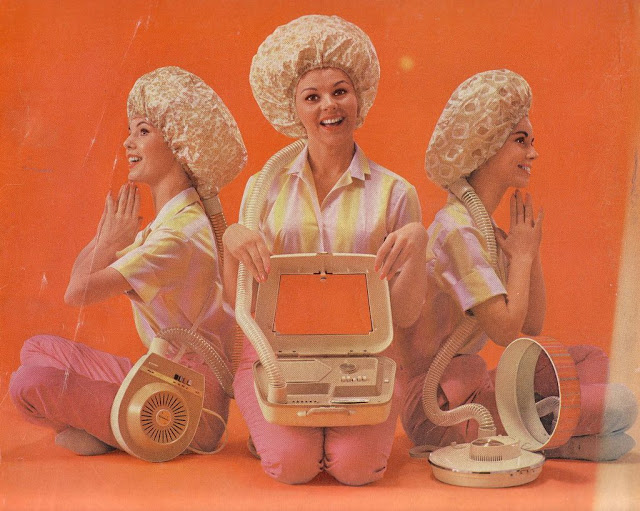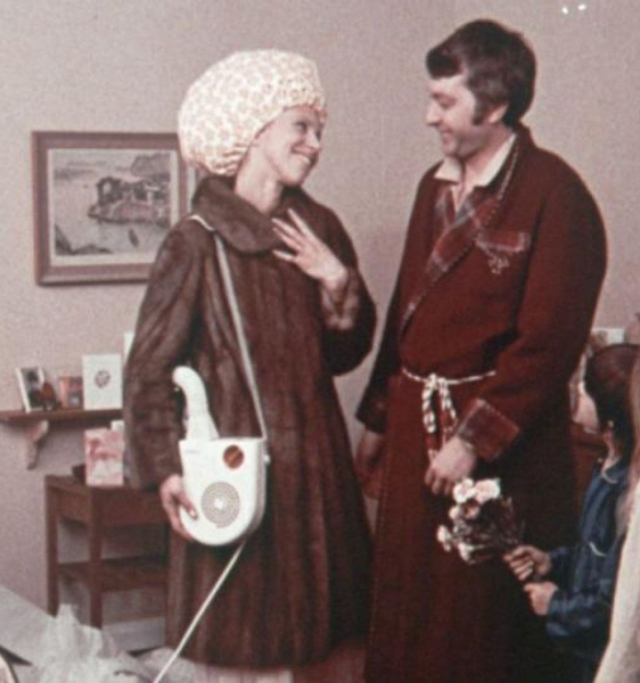The home hair dryer is a big success these days, and little wonder. New models are a far cry from the first models, which had to be held, or were used with a sort of wind tunnel over the head.
To make best use of the home hair dryer, plan setting sessions for a time when other beauty chores can be done. A facial treatment, pedicure and manicure suggest themselves.
Of course, the great boon of the home hair dryer is its speed. When hair is set on large rollers, it can dry a coiffure fast enough to allow for morning settings. This can mean eliminating the custom of sleeping all night on rollers.
Coiffures can be quickly refreshed with modern dryers. The heat settings on modern home dryers are controllable, so women can have the warmth they prefer. Use these controls to dry different hair textures properly. Coarser hair can stand higher heat than fine hair.
If the hair is smoothly rolled and dried at the proper temperature, its sheen and life will be measurably improved. Dry overly curly hair at a low heat and it will kink less. Straight hair dried at higher temperatures seems to have more body.


























The hair dryer in the third photo down from the top, that looks like the one I have. I got it used in 1986 --it was probably ten or fifteen years old then-- and it still works great for my purpose: It's next to the bed, with the hose going under the blankets (no hood). In winter I switch it on low or medium while I brush my teeth. So except when the power was out I've never had to get into a cold bed since. When it's cold in the house and the bed is hot inside when you get in, it's so perfect.
ReplyDeleteA couple of times over the years it began to rattle. I took it apart, reset the motor bearings, screwed it back together, and it's good as new. Also one time the switch failed so I put in a switch from something else.
I have a vacuum cleaner from the Korean War era. The electrical cord wears out every ten or fifteen years where it strains at the grommet, and when that happens I cut a few inches off and open the case and reattach it inside with wire nuts. It has a big-mouth cloth bag that you empty into the trash bin and put back. You never have to buy a bag. It just keeps working and working, for the shop and the house. There were several winters in the late 1980s and early 1990s where I used it, on a very long hose to the back room to keep the noise out, to force air through the woodstove convection vents, and it was often running continuously all night, a forced air furnace.
Look at the appliances and tools and things of recent vintage, your vacuum cleaner or toaster or microwave oven or iron or bathroom heater or whatever. Try to imagine, with a straight face, these things lasting in normal use even for just five years before breaking without possibility of cheap or free repair. Try to imagine any appliance made today lasting eighty or a hundred years.
I have a 600-watt G.E. Focalypse silent parabolic reflector room heater that was made in the 1930s. Only a couple of years ago its resistance coil corroded to the point of being unfixable. It doesn't have a switch. It has no moving parts. You turned it on by plugging it in. I was just at the hardware store yesterday and I walked down a whole aisle of electric heaters, all made of plastic, and every one of them had a digital display, a fragile touch-panel, and a little computer in it (!); many of them had a remote-control wand requiring batteries. I would be surprised to find one in ten of those units still working in five years. There's a shed for electronics at the local dump that's always full of broken electric heaters and inkjet printers and music electronics and teevee sets and so on. (That reminds me: I'm still using my H.P. Laserjet 5MP printer that was made in 1996, that I bought used in the early 2000s. When cheap toner cartridges got scarce for it I started buying toner in bottles and refilling my own. It costs $5 for enough toner to print 2,500 pages.
The main thing that goes wrong with big flat-screen teevee sets is the cheap capacitors in the power supply or on the motherboard. It would have cost an extra dollar or two each set for the manufacturers to build every one of those teevees to last until someone shot it with a crossbow.